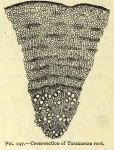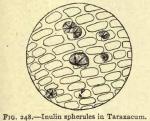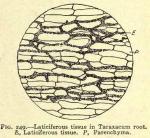553. Taraxacum.—Taraxacum. Dandelion.
The dried rhizome and roots of Tarax'acum officina'le Weber. Preserve the thoroughly dried drug in tightly closed containers, adding a few drops of chloroform or carbon tetrachloride from time to time, to prevent attack by insects.
BOTANICAL CHARACTERISTICS. —Root perennial; leaves radical, runcinate, pinnatifid or lyrate; scape hollow. Flower-head solitary, many flowered, yellow. After blossoming, and while the fruit is forming, a pappus raises which soon exposes to the wind the naked fruit, which is blown about.
SOURCE.—A plant of very extensive geographical distribution, native to Europe, but very abundant in the United States, where, in some parts, it is a troublesome weed.
Dandelion root may be dug from July to September, during which time the juice it contains becomes thicker and more bitter. The roots should be washed and carefully dried, and care should be taken to avoid maggots, which attack the well-dried roots.


 DESCRIPTION OF DRUG.—The dry root is fleshy, long, and tapering, seldom branching; 5 to 25 mm. to 1 in.) thick at the top, surmounted by several heads. Externally brownish, soon darkening by exposure. In the fall, about November, the root acquires a deep orange color throughout. Internally white, abounding in a bitter, inodorous, milky juice. A cross-section displays a thick, white bark with numerous concentric circles of laticiferous vessels surrounding a yellow woody center. The central column is easily separated from the thick bark, when the former is found to have along its exterior at intervals minute knotty projections; a cross-section of the root at this point shows woody fibers branching from the ligneous cord, penetrating, and passing through, the bark.
DESCRIPTION OF DRUG.—The dry root is fleshy, long, and tapering, seldom branching; 5 to 25 mm. to 1 in.) thick at the top, surmounted by several heads. Externally brownish, soon darkening by exposure. In the fall, about November, the root acquires a deep orange color throughout. Internally white, abounding in a bitter, inodorous, milky juice. A cross-section displays a thick, white bark with numerous concentric circles of laticiferous vessels surrounding a yellow woody center. The central column is easily separated from the thick bark, when the former is found to have along its exterior at intervals minute knotty projections; a cross-section of the root at this point shows woody fibers branching from the ligneous cord, penetrating, and passing through, the bark.
Inulin spherules are plainly discernible under the microscope if, before sectioning, the fresh root be macerated in alcohol. The root loses in drying from 78 to 88 per cent. of moisture. The dried root is longitudinally and spirally wrinkled; when quite dry, has a brittle fracture, showing a dark brown exterior and a thick, white bark.
Powder.—Characteristic elements: See Part iv, Chap. I, B.
CONSTITUENTS.—Taraxacin (a bitter principle), taraxacerin, C9H15O, resin, inulin, sugar, and mucilaginous substances. The percentage of sugar varies with different seasons and with condition of soil; it is said to diminish in the summer. Recent investigations have shown the existence of an alkaloid. But this has been found to be exceedingly minute-a mere trace. Ash, not more than 10 per cent.
Preparation of Taraxacin.—Treat decoction with animal charcoal, wash the latter with water, and dissolve out bitter principle with boiling alcohol; evaporate. It has not been proven that this is crystalline. Composition uncertain.
ACTION AND USES.—Deobstruent, tonic. As a remedial agent dandelion root has not been properly appreciated, possibly because it is such a common weed. It is worthy of more study on the part of pharmaceutical chemists and clinicians. The fluidextract and extract are used in hepatic disorders. Dose: 1 to 4 dr. (4 to 15 Gm.)
- OFFICIAL PREPARATIONS.
- Fluidextractum Taraxaci Dose: 1 to 4 fl. dr. (4 to 15 mils)
- Extractum Taraxaci 5 to 60 gr. (0.3 to 4 Gm.).

